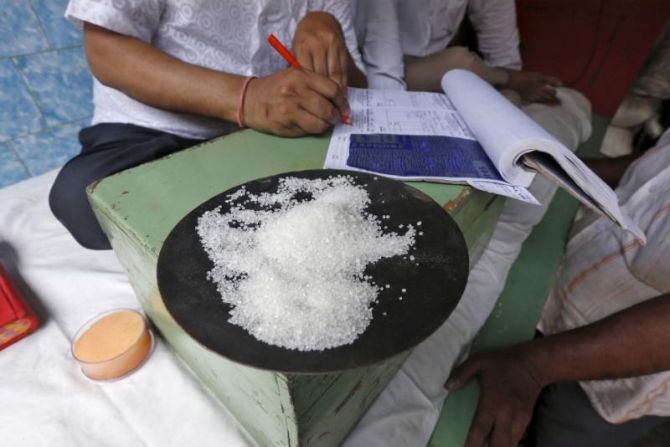Presently director at the Indian Council of Agricultural Research’s Sugarcane Breeding Centre in Coimbatore, Bakshi Ram's next target is to improve both cane yields and sucrose content in cane varieties cultivated beyond the Vindhyas in Tamil Nadu and Karnataka, as also Maharashtra.

The country’s sugar sector is staring at an unprecedented glut, with the year’s output topping 31 million tonnes, far above domestic consumption and at prices well below the (state-set) cost of production.
More and more mills are finding it difficult to make payment for sugarcane to farmers, especially in the politically sensitive state of Uttar Pradesh.
At the heart of the surplus lies a new variety of cane called CO-0238. It occupies over half the cane area in northern India, from a mere 3 per cent in 2012-13 when it was first recommended by the UP government.
However, the man behind the wonder variety, Bakshi Ram, bottom, left, isn’t willing to settle at this.
Presently director at the Indian Council of Agricultural Research’s Sugarcane Breeding Centre in Coimbatore, his next target is to improve both cane yields and sucrose content in cane varieties cultivated beyond the Vindhyas in Tamil Nadu and Karnataka, as also Maharashtra.
“My work with north Indian cane farmers has made is easy to convince southern mills to adopt newer varieties. I am sure that in the next three years, recovery (of sugar from cane) will jump in South India as well, particularly in Tamil Nadu,” he said.
Bakshi Ram is no ordinary plant breeder. In the past decade or so, he has released no less than 14 sugarcane varieties, mostly in north India - some highly successful and some with moderate degrees of success and acceptability among farmers.
Of these, C0-0238 has been a super-hit, both among farmers and millers. It gives a higher per hectare yield than other varieties and also has higher sucrose content. The former benefits farmers and the latter gladdens millers.
A gold medallist in agriculture science for his graduate and postgraduate degree, sugarcane research didn’t come naturally to Ram.
“I hardly knew a word on it when I first joined the Sugarcane Breeding Institute in Coimbatore in 1986,” he says.
 For six months, says Ram, he sat in the Institute’s library and read almost everything about the crop.
For six months, says Ram, he sat in the Institute’s library and read almost everything about the crop.
The wealth of knowledge he gained helped him understand two basic things about the crop.
The first was that cane grown in sub-tropical India (that is in most of north India, comprising UP, Uttarakhand, Punjab and Haryana) was thinner than those grown in tropical India.
Second, that cane yield is negatively proportionate to sucrose content.
Bakshi Ram took it upon himself to change these. For 21 years, starting 1986 (except for seven year gap in between for higher studies), Ram worked on cane varieties at both Coimbatore and Karnal (Regional Centre for Sugarcane Breeding) to develop varieties which challenged the established conventions.
It takes 12-13 years to identify, develop and release a cane variety at the national level.
“I released my first variety, CO-98014, in 2007 and several more thereafter. But, it was CO-0238 which was liked by farmers the most and cultivated in a big way,” he says.
CO-0238 was first tested in the cane mills of Simbhaoli and also DSCL Ajbapur, in Uttar Pradesh.
After DSCL opted out, Simbhaoli continued showing interest in the variety and convinced farmers in its area to grow the cane.
Later, Indian Sugar Mills Association joined in and conducted fields trials at 22 mills spread across UP, Bihar, Haryana and Uttarakhand.
This gave confidence to sugar factories to adopt CO-0238 in a big way.
“The multi-location field trials enabled the cane to cross UP’s borders and become a national talking point. Else, it would have remained confined to UP,” Ram said.
In 2012, once the UP government started recommending the variety, its acceptability among farmers zoomed. From 3 per cent of the sown area in 2012-13, it occupied 52 per cent of all cane area in UP during the current, 2017-18, season.
“For years, I didn’t leave office on time and worked even on Sundays to devote time on the sugarcane varieties. So much so that my kids call sugarcane as my first wife. All of which is bearing results,” Ram says.
Bakshi Ram prepares to retire after three more years. He says he would love to continue work among cane farmers and varieties.
“I come from a farming family of north India and hard work comes naturally to me,” he says.
As India looks at a prolonged period of good cane production, it is people like Bakshi Ram who emerge as heroes.
Photograph: Rupak De Chowdhuri/Reuters











